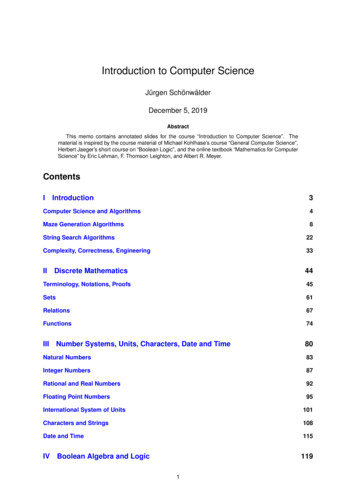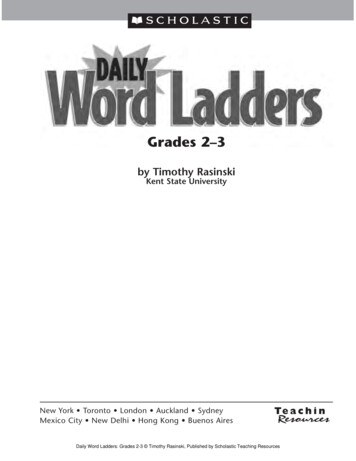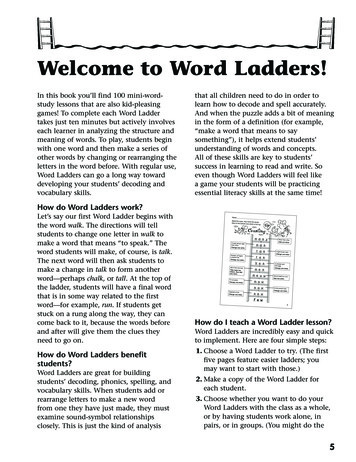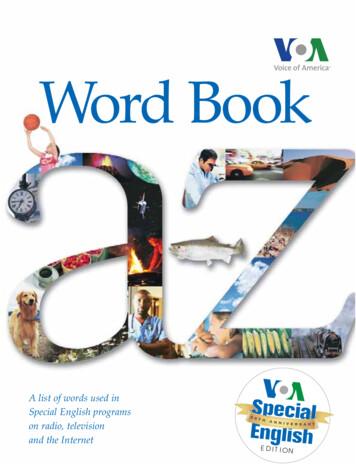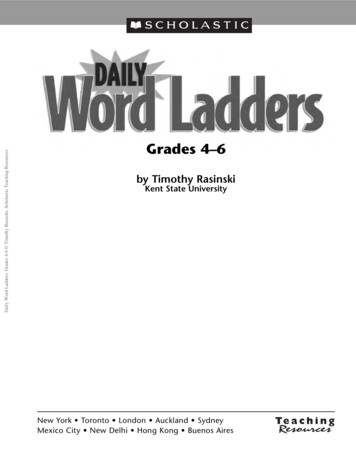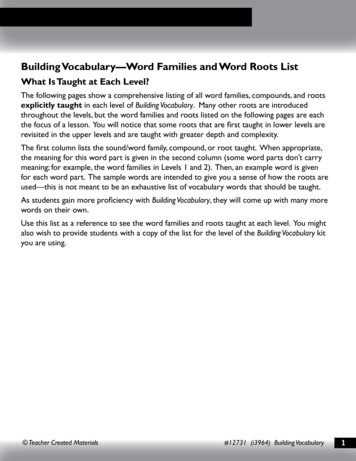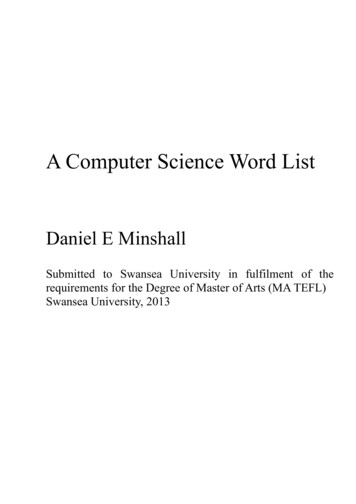
Transcription
A Computer Science Word ListDaniel E MinshallSubmitted to Swansea University in fulfilment of therequirements for the Degree of Master of Arts (MA TEFL)Swansea University, 2013
Summary:This study investigated the technical vocabulary of computer science in order to create a ComputerScience Word List (CSWL). The CSWL was intended as a pedagogical tool in the instruction ofnon-native English speakers who are studying computer science in UK universities. In order tocreate this technical word list, a corpus of 3,661,337 tokens was compiled from journal articles andconference proceedings covering the 10 sub-disciplines of computer science as defined by theAssociation for Computing Machinery (ACM). The CSWL was intended to be supplemental to boththe General Service List (GSL) (West, 1953) and the Academic Word List (AWL) (Coxhead, 2000)and was created using the criteria established by Coxhead (2000) for word selection. The CSWLcontained 433 headwords and in combination with the GSL and AWL accounted for 95.11% of alltokens in the corpus. This was sufficient to meet the lexical threshold for sufficient understanding ofa text as proposed by Laufer (1990). This study also conducted research into the technicality of theCSWL by comparison to other corpora, comparison to a technical dictionary and an investigation ofthe distribution of its headwords against the BNC frequency bands. Overall, the CSWL was foundto be highly technical in nature. The final part of the research looked into the existence of multiword units in computer science literature to build a Computer Science Multi-Word List (CSMWL)from the same corpus. A total of 23 items comprised the CSMWL and they were again chosen usingthe same criteria of range and frequency as established by Coxhead (2000). The CSMWL showedthat whilst multi-word units do exist in computer science literature, they are mostly compoundnouns with domain specific meaning.
DECLARATION:This work has not previously been accepted in substance for any degree and is not beingconcurrently submitted in candidature for any degree.Signed . (candidate)Date .STATEMENT 1This dissertation is the result of my own independent work/investigation, except where otherwisestated. Other sources are acknowledged by footnotes giving explicit references. A bibliography isappended.Signed . (candidate)Date .STATEMENT 2I hereby give my consent for my dissertation, if relevant and accepted, to be available forphotocopying and for inter-library loan, and for the title and summary to be made available tooutside organizations.Signed . (candidate)
RECORD OF SUPERVISION2012 - 13NB: This sheet must be brought to each supervision and submitted with theDissertation.completed(The following record must be completed as appropriate by student and supervisor at the end of each supervisionsession, and initialed by both as being an accurate record. NB it is the student’s responsibility to arrange supervisionsessions and he/she should bear in mind that staff will not be available at certain times in the summer ). If any ofthese supervisions are conducted by email, Skype or any other electronic means, this should be clearly indicated in the‘Notes’ column.Student Name: Daniel E MinshallStudent Number: 148047Dissertation Title: A Computer Science Word ListSupervisor: Dr. Vivienne sSupervisorstudent1: Brief outline of researchquestion and preliminarytitle (by pre June)2: Discussion of detailedplan and bibliography(by June)3: Progress report,discussion of draft chapter(by August)4: (optional) progress report(by September)5: Submission(September )Statement of originality: I certify that this dissertation is my own work and that where the work ofothers has been used in support of arguments or discussion, full and appropriate acknowledgement hasbeen made. I am aware of and understand the University’s regulations on plagiarism and unfair practiceas set out in the ‘School of Arts and Humanities Handbook for MA Students’, and accept that mydissertation may be copied, stored and used for the purposes of plagiarism detection.Signed:. Date: .
Contents:ChapterSectionPage1: Introduction12. Literature Review22.1 Introduction22.2 Definition and categorisation of words22.3 Frequency, vocabulary size, coverage and comprehension52.4 Word technicality82.5 Multi-word units112.6 The GSL, AWL and specialist word lists132.7 Conclusion173. Research Questions194. Methodology204.1 Building the Computer Science Corpus (CSC)204.2 Selecting texts for the CSC234.3 Editing texts for the CSC244.4 Software264.5 Clearing unwanted data from the CSC274.6 Criteria for selection of technical words in the CSWL284.7 Completing the CSWL304.8 Conclusion315. Results325.1 Coverage of the GSL and AWL in the CSC325.2 Coverage of the CSWL in the CSC335.3 Coverage of the CSC with the BNC and BNC/COCA wordlists355.4Technicality of the CSWL365.4.1 Comparison against another computer science corpus375.4.2 Comparison against a fiction corpus385.4.3 Comparison against a technical dictionary405.5 Multi-word units in the CSC415.5.1 Hyphenated and compound words in the CSWL425.5.2 Multi-word units outside the CSWL436. Discussion456.1 Introduction456.2 Coverage of the GSL and AWL456.3 Contents and coverage of the CSWL46
6.4 Efficiency of the GSL/AWL/CSWL against the BNCfrequency bands476.5 Technicality and distribution of the CSWL486.6 Multi-word units in the CSC507. Conclusion528. Limitations andsuggestions for futureresearch52Appendices53ReferencesAppendix A: The Computer Science Word List (CSWL)53Appendix B: The Computer Science Multi-Word List(CSMWL)57Appendix C: CSCPC Bibliography58Appendix D: CSJAC Bibliography78Appendix E: Test computer science corpus bibliography90Appendix F: Test fiction corpus bibliography9294
1. IntroductionData from the Higher Education Statistics Agency (HESA) (http://www.hesa.ac.uk/) shows that17.4% of all students studying in UK universities for the academic year 2011/2012 were non-UKdomicile. This is an increase by 1.6% over the previous year. Also, for the same year, 4.68% of allstudents who graduated from UK universities did so in a computer science related subject. Thissuggests that as the number of non-native English speakers studying in UK universities is on theincrease and as computer science is such an influential and widely studied discipline, there is anincreasing demand for pedagogical tools to be designed for the assistance of L2 English learnersstudying this subject.English for Specific Purposes (ESP) teaching and its sub-branches like English for AcademicPurposes (EAP) have grown in recent years to accommodate for the increased intake of non-nativespeakers into UK universities (Jordan, 2002). This area of teaching has been assisted in particularby research into the vocabulary used in an academic English environment (e.g. Coxhead, 2000).One of the findings of this research is that whilst there may be considered a general academicvocabulary, it is also important to instruct students in the technical language they will utilise in theirown studies. There is a difference in the language of medicine compared to engineering. This studyintends to compensate for the lack of any research conducted into the specialist lexical needs ofnon-native speakers studying computer science through an English medium. Specifically it intendsto compile a technical word list for computer science students derived from corpus analysis.In order to accomplish this, it will first review the current state of vocabulary research (chapter 2).This is intended to provide the motivation for the research questions which will be proposed(chapter 3). Following this, there will be an outline of the methodology utilised in building thecorpus data and extracting a word list from it (chapter 4), and the results of these will then bedemonstrated (chapter 5). Once these results have been obtained they will be discussed in light offindings from other similar studies (chapter 6), before this paper is concluded (chapter 7) and anysuggestions for further research are disclosed (chapter 8).1
2. Literature Review2.1IntroductionThe purpose of this study was to investigate the viability of a technical word list for the discipline ofcomputer science. This Computer Science Word List (CSWL henceforth) was designed to act as asupplement to both the General Service List (GSL) (West, 1953) and the Academic Word List(AWL) (Coxhead, 2000). The intention was that it would be possible for an L2 learner of Englishstudying this subject in an English medium to use such a list as a pedagogical tool.In order to accomplish this, it is first necessary to discuss the current state of research intovocabulary relevant to this study. This review will show how a word may be defined andcategorised, the idea of frequency and the notion of vocabulary size, coverage and their relationshipwith comprehension. It will also consider the technicality of a word, the increasing importance inrecent research on collocational behaviour and how phrasal expressions could be included in asupplemental word list. Finally, it will discuss studies which have created technical word lists inother disciplines as well as the GSL and AWL.2.2Definition and categorisation of wordsOne major research problem involved in studying vocabulary is that, as a unit of measurement, theword can be difficult to clearly define and hence count (Milton, 2009). Any empirical study, inparticular a quantitative study such as this one, requires precisely countable units of measurement.However, there are many different ways of counting words and this can lead to huge variations innumbers, if these different methods are employed. The typical example given of this is the countmade of word families in Webster's Third International Dictionary by Nation (2001a) and Schmitt(2000). Their counts were 54,000 and 114,000 respectively. This level of disagreement illustratesthe need for clear criteria to be established in the way words may be counted.A simple count of words in a text can be restricted to tokens and types. Tokens are the number ofrunning words in a text whilst types are the unique occurrence of each word in any text. Using bothof these measurements will commonly lead to different values for each because of the re-occurrenceof common (often function) words as in the sentence He ate his dinner before he went out. There2
are 8 tokens here, but only 7 types due to the repetition of the word he. Tokens are important for anycorpora-based research (e.g. Coxhead, 2000; Konstantakis, 2010) as this is the unit by which thesize of the corpora are counted. Types are relevant to a technical word list as they are themorphemes of a headword which are included in its expansion.Words may have many lexical types so they become increasingly difficult to count once theirinflections and derivations are considered. Inflections influence a word's grammatical properties,often for verb agreement purposes or plural meaning, but do not change the part of speech, such aswith quick and quickest. Words counted this way are known as lemmas. Derivations are affixes to abase word which can change its word class and meaning, such as quick to quickly. Counting wordsin this way, including both derivations and inflections, is called using word families. Previoustechnical word list studies (e.g. Coxhead, 2000; Coxhead & Hirsch, 2007; Konstantakis, 2007;Wang et al, 2008) have employed word families to produce fully expanded versions of theheadword entries in such lists.The concept of word families means that words such as visible, invisible and invisibility are allconsidered part of the same word family. This greatly reduces the number of words in the Englishlanguage, based on the assumption that there is little or no extra burden for learning the inflectionsand derivations of a word once the grammatical rules for doing so are known by a non-nativespeaker (Nation, 2001a). Research from other studies has shown that this is likely. Levelt (1989)proposed a model for how speech is produced, which was partly based on previous work on speecherrors (Fromkin, 1973). It demonstrated how encoding of language is a function of the brain calledformulation which is in turn dependent on a lexical store which must contain the various inflectionsand derivations of a word.However, not all inflections and derivations of a word provide a similar learning burden due toirregularities and this may lead to overestimates of a student's vocabulary size (Laufer, 1990). Forthis reason, Nation and Bauer (1993) created a list of 7 levels across which word families could beorganised, based on the frequency and regularity of their affixes. They considered level 7 words asthose which have classical roots and affixes which need to be learnt separately by both native andnon-native speakers alike. These word families contain a headword with an expanded list of typesof the same headword. For example, the headword act contains the types acted, acting and acts, butnot actor as the -or affix is not within level 6 expansion. With this as a limiting factor on how alexical type may be considered part of a word family, Coxhead (2000) decided upon level 63
expansion for headwords within the AWL. Further research, which built on the AWL, has alsoagreed on this level of expansion (e.g. Coxhead & Hirsch, 2007; Konstantakis, 2007; Wang et al,2008). Table 2.1 illustrates how a word may be expanded as far as level 6.Level 1A different form is a different word. Capitalization is ignored.Level 2Regularly inflected words are part of the same family. The inflectional categories are - plural; thirdperson singular present tense; past tense; past participle; -ing; comparative; superlative;possessive.Level 3-able, -er, -ish, -less, -ly, -ness, -th, -y, non-, un-, all with restricted uses.Level 4-al, -ation, -ess, -ful, -ism, -ist, -ity, -ize, -ment, -ous, in-, all with restricted uses.Level 5-age (leakage), -al (arrival), -ally (idiotically), -an (American), -ance (clearance), -ant (consultant),-ary (revolutionary), -atory (confirmatory), -dom (kingdom; officialdom), -eer (black marketeer),-en (wooden), -en (widen), -ence (emergence), -ent (absorbent), -ery (bakery; trickery), -ese(Japanese; officialese), -esque (picturesque), -ette (usherette; roomette), -hood (childhood), -i(Israeli), -ian (phonetician; Johnsonian), -ite (Paisleyite; also chemical meaning), -let (coverlet),-ling (duckling), -ly (leisurely), -most (topmost), -ory (contradictory), -ship (studentship), -ward(homeward), -ways (crossways), -wise (endwise; discussion-wise), anti- (anti-inflation), ante(anteroom), arch- (archbishop), bi- (biplane), circum- (circumnavigate), counter- (counter-attack),en- (encage; enslave), ex- (ex-president), fore- (forename), hyper- (hyperactive), inter- (interAfrican, interweave), mid- (mid-week), mis- (misfit), neo- (neo-colonialism), post- (post-date),pro- (pro-British), semi- (semi-automatic), sub- (subclassify; subterranean), un- (untie; unburden).Level 6-able, -ee, -ic, -ify, -ion, -ist, -ition, -ive, -th, -y, pre-, re-.Table 2.1 Word family levels (Nation, 2012)As has been seen, there are precise ways in which a word may be counted. Understanding thedefinition of tokens, types and word families (expanded to level 6) is central to any technical wordlist study.4
2.3Frequency, vocabulary size, coverage and comprehensionThe frequency of a word is generally defined as the number of times it occurs (as a word family)per token of a text. Whilst it is still an assumption that a word's frequency has an effect on its abilityto be learnt, it seems a reasonable one to make and there is strong supporting evidence for thisclaim. Milton (2006) obtained a statistically significant relationship between frequency bands andvocabulary size scores using an ANOVA ( F 93.727, p 0.001) on a study of 227 L2 Englishlearners in a Greek school. These frequency bands have been produced through frequency-basedcorpora research (e.g Nation & Heatley, 2002). They are a way of demonstrating how common aword is by grouping them together in 1,000 word bands, such that the 1k frequency band containsthe most common 1,000 words in a language and the 2k frequency band contains the second mostcommon 1,000 words and so on. If frequency suggests a word is more likely to be learnt, then themore frequent a word, the more likely it is to reoccur in a text and the more likely it is to beunderstood by the reader. This leads to the concept of coverage: the percentage of tokens in a textthat an L2 reader understands.Connected to the notion of coverage is the idea of a lexical threshold. This figure is also given as apercentage and represents the coverage required for sufficient comprehension of any givendiscourse. Laufer (1989) studied 100 L2 learners of English at the University of Haifa. They weregiven a reading comprehension exercise in which they were also asked to mark the vocabulary theyunderstood. Those students who had lexical coverage of at least 95% of the text performedsignificantly better than those who did not, which allowed Laufer to postulate this figure as aminimal threshold for comprehension. However, Laufer's definition of significantly betterperformance was based on an unconventional evaluation: the minimum pass mark for anexamination at the University of Haifa, which was set at 55%. Whilst this particular level ofperformance might be considered arbitrary, Laufer did at least demonstrate a significant effect atthis point. Liu and Nation (1985) also agreed with this lexical threshold of 95%.Hu and Nation (2000) tested 66 L2 learners of English, who studied at university level and hadperformed well on a Vocabulary Levels Test (Nation, 1983), with a reading activity. Such tests arean attempt to evaluate an L2 learners vocabulary size by sampling their understanding of wordsfrom increasingly less common frequency bands, which also contain dummy words set to controlfor guessing. Their results demonstrated a predictable relationship between comprehension and5
unknown word density and found that whilst 90-95% coverage was sufficient for some of theirsubjects to perform adequately, far better results were obtained at 98% coverage. Their findingsagreed with an earlier paper by Hirsch and Nation (1992), which investigated the relationshipbetween lexical coverage and known and unknown words. They noticed a non-linear connectionbetween these 2 factors such that there was a steep drop in word density known at the 98% mark. Amore recent study (Schmitt, Jiang & Grabe, 2011) revealed a linear relationship between coverageand comprehension in the reading ability of 611 L2 learners of English. In effect, they found nothreshold value indicated by a sudden increase in comprehension at any level of coverage, but againconcluded that 98% coverage was a more reliable target.The research to date would suggest that for optimal comprehension of any text there is a thresholdof coverage between 95-98%. However, this is not an absolute value. It should be remembered thatthis is an ideal figure and that sufficient comprehension of a text with a lower threshold coveragemay be obtained. The problem with setting the threshold to 98% is one of diminishing returns.There is not a linear relationship between coverage and words known (Hirsch & Nation, 1992). Ascoverage demands increase, vocabulary sizes become exponentially higher to meet them. This iswhy almost all technical word list studies have considered 95% to be a better threshold value (e.g.Coxhead, 2000; Coxhead & Hirsch, 2007; Konstantakis, 2007, 2010; Wang et al, 2008). It shouldalso be noted that none of the studies which suggested a 98% lexical threshold (Hirsch & Nation,1992; Hu and Nation, 2000; Schmitt, Jiang & Grabe, 2011) used technical corpora to calculate thisfigure. The most technical was the Schmitt, Jiang and Grabe study (2011) which used an articlefrom an EFL textbook and from The Economist. The others used works of popular fiction.It is possible to calculate how many words an L2 learner of English requires with these thresholdfigures in mind, if used in conjunction with corpus analysis. Nation (2001a) used the Carroll,Davies and Richman corpus (1971) to estimate that approximately 12,000 lemmas were required toobtain 95% lexical coverage. In later research, Nation (2006) revisited this word count followingthe construction of fourteen 1,000 word-family lists (frequency bands) from the British NationalCorpus (BNC) based on their relative frequency. Using these lists, he was able to test theirreliability through comparison with other corpora and found a good level of rigour which suggestedthat these lists were representative of the English language as a whole. From this point, it waspossible to calculate how many words an L2 learner of English would require to read a variety ofdifferent texts, including novels, graded readers and newspapers. Using a threshold of 98%, heconcluded that approximately 8,000-9,000 word families were needed to understand such texts.6
This estimate has been converged upon by similar studies. Laufer and Ravenhorst-Kalovski (2010)estimated 8,000 word families (with the inclusion of proper nouns) for the 98% lexical threshold tobe obtained, with as few as 4,000-5,000 for the 95% threshold. However, their study was notcorpus-based. It might seem that even a target vocabulary size of 8,000-9,000 words might presenttoo difficult an impediment for an L2 learner of English to overcome (Milton, 2009), yet there arereasons why these studies might not properly represent such a student's needs. These corporacontain a number of different types of register, from formal through to informal writing in manydifferent contexts. The L2 learner may not have need of a spectrum of registers dependent on theirreasons for learning an L2. This is particularly important for ESP students.The research considered thus far has shown that it is possible to estimate the number of words an L2learner of English may require by using the idea of coverage, a lexical threshold and corpus data.However, these vocabulary size estimates have been made for general learners of English ratherthan those studying ESP. These L2 learners have need of a specialist lexicon for their subjectspecific studies. For these L2 learners, a more specific corpus analysis is required using literaturefrom their discipline (e.g. Konstantakis, 2007) and general academic registers (Coxhead, 2000).Specialist L2 learners might still need access to non-technical vocabulary in the course of theirlanguage practice, but due to the limited amount of hours teachers have available to instruct theirstudents (Milton, 2009), it becomes more expedient to concentrate on a specialist lexicon.The GSL is a list of almost 2,000 words (section 2.6) which provides approximately 80% coverageof general English texts (Coxhead, 2000). Indeed, this 2,000 word benchmark is often cited as anecessary basis for gist understanding of the English language (Nation, 2001a), although a morerecent paper asks that this be raised to the 3,000 word mark (Schmitt & Schmitt, 2012). However,the GSL provides only about 75% coverage of academic texts (Coxhead, 2000). With only 570word families, the AWL provides a further 10% coverage on average in many different academicdomains (Coxhead, 2011), making a total of 85% coverage when combined with the GSL. This isconsiderably lower than any acceptable lexical threshold, but obtained with roughly 2,570 wordfamilies. Most other technical word list studies (section 2.6) have attempted to bridge this gapbetween the amount of tokens accounted for by a combination of the GSL and AWL with theproposed lexical thresholds for comprehension. An exception to this is Ward (1999) who compiledan engineering corpus of approximately 1 million words from which he created an engineeringword list. He concluded that only 2,000 words were necessary to obtain 95% coverage inspecialised engineering texts for first year engineering students. He did not use the GSL or AWL as7
he intended to increase the efficiency of vocabulary teaching by removing any words from the GSLand AWL which his corpus data showed to be absent from engineering texts. However, at only 1million words, it may be argued that his sample size was insufficient to make such claims.Nonetheless, it was a demonstration of how specialist corpus studies can establish word lists with areduced vocabulary burden for ESP students with a level of efficiency far better than learning thefirst 8-9k frequency bands (Nation, 2006). This also applies to building a supplementary specialistword list. Vocabulary size efficiency in achieving threshold coverage is critical.2.4Word technicalityIt has already been discussed how words occur in the English language with differing frequency.Some, such as those found in the GSL, are amongst the most commonly used. Nation (2001a)differentiated between 4 different categories of words based on this frequency behaviour: highfrequency, academic, technical and low-frequency words. The purpose of defining words in such away is for pedagogical reasons. There should be a cost/benefit analysis involved in the decision toteach items of vocabulary and there is a greater benefit in teaching high-frequency items (Nation,2001b). Therefore, a teacher may concentrate on teaching the high-frequency words in English asthey are most likely to be encountered by any student. Less time may be committed to teaching thelow-frequency words as they are, by definition, a lot less common in language.There has been a tendency to consider the most common 2,000 headwords in the English languageas the high-frequency lexis (Nation, 2001a). This is mostly a result of the GSL being set at roughlythis number, in addition to other research which helped shape this number as significant. One suchstudy was conducted by Schonell, Middleton and Shaw (1956). They recorded and manuallytranscribed instances of spontaneous speech and some interviews of 2,800 semi-skilled Australianlabourers. They used this data to build a corpus of approximately half a million words. Theirfindings suggested that only 209 word families were sufficient to provide 83.44% coverage of theircorpus and that a language threshold of 95% could be obtained with only 1,600 word families.These numbers converge with the idea of there being 2,000 high-frequency words. However, morerecent studies using the modern Cambridge and Nottingham Corpus of Discourse in English(CANCODE) corpus by Adolphs and Schmitt (2003) found that only 93.93% coverage could beobtained with these 1,600 word families. In fact, they required 3,000 word families to exceed thethreshold coverage value of 95%. Cobb (2007) looked at 30 target words from each of the 1,0003,000 frequency bands of the BNC. On comparison with a 517,000 extract from another corpus, he8
found that words from each of these bands occurred with sufficient frequency to be considered ashigh-frequency. It is with evidence from research like this that Schmitt and Schmitt (2012) call for are-categorisation of the high-frequency range to include the first 3,000 words in English.Low-frequency vocabulary is easier to categorise. Using the Range programme (Nation & Heatley,2002), Nation revisited his earlier work (Nation, 2001a) to change his recommendation forthreshold coverage at 98% (section 2.3). Using a range of texts from different registers, heconcluded that approximately 8,000-9,000 words are sufficient in English to obtain this threshold.His data showed a very strong drop-off point after this where each further 1,000 frequency bandprovided progressively less and less coverage. Using this data, Schmitt and Schmitt (2012)categorised low-frequency words as anything after this point.Mid-frequency vocabulary is therefore those words which exist between the 3,000 high-frequencyrange and the 9,000 low-frequency range (Schmitt & Schmitt, 2012). It may be expected thatacademic and technical vocabulary may be found within this part of the spectrum. Using a LextutorBNC-20 frequency analysis, they noted that 64.3% of the headwords from the AWL were within the3,000 high-frequency range. However, the rest of the AWL did occur within the parameters of theirmid-frequency vocabulary. Laufer and Ravenhorst-Kalovski (2010) found that university studentsin Israel required 6,000-8,000 word families to cover 98% of the examination reading texts in orderto obtain a mark on a university entrance examination which showed they had sufficientcomprehension to read academic material independently. Guided reading required knowledge of4,000-5,000 word families, which allowed 95% coverage. Thus academic vocabulary may be foundacross the mid-frequency range and its knowledge is essential for L2 learners of English in auniversity setting. Receptive knowledge of this vocabulary will enhance a student's ability tounderstand academic writing and speaking, whilst a productive knowledge may help a student'sability to write and speak in such a register (Nation, 2008).Academia is a large field with many widespread disciplines. Different subject areas may use thesame words with different meanings and this leads to the issue of monosemic bias, as a homographcould misrepresent the composition of word families and hence affect the burden of learning suchwords (Wang & Nation, 2004). Whilst their study did not find this effect, one by Hyland and Tse(2007) did. The example given was that the word process was far more likely to be encountered as anoun by science and engineering students than by social scientists, who more frequently encounterit as a verb. This highlights the overlap between the categories of words which Nation (
computer science. This Computer Science Word List (CSWL henceforth) was designed to act as a supplement to both the General Service List (GSL) (West, 1953) and the Academic Word List (AWL) (Coxhead, 2000). The intention was that it would be possible for an L2 learner of EnglishFile Size: 516KB
